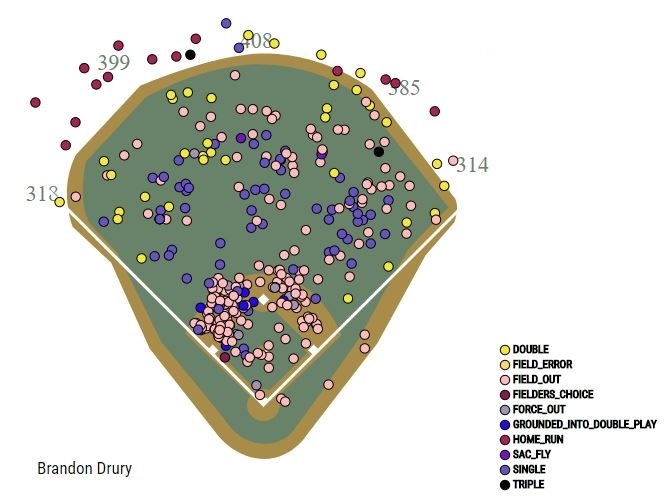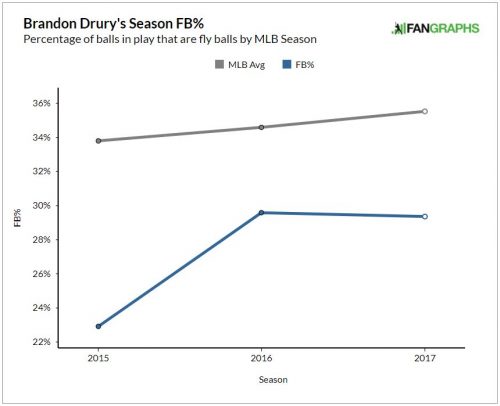Let’s talk about Brandon Drury. The Yankees seem to be valuing guys who can play multiple positions lately. Not only Drury, but players like Tyler Wade, Neil Walker, Ronald Torreyes, are all going to be on the Yanks 25-man roster come Opening Day. This is a bit of a change in philosophy that has swept through the organization the past few years.
As the long term contracts were expiring, the Yankees tried to surround Derek Jeter, Mark Teixeira, and company with secondary talent. Some of the forgettable secondary names that were utilized: Randy Winn, Ben Francisco, Travis Hafner, and Stephen Drew, just to name a few guys that you’ve likely whitewashed from your memory. Now, back to Drury. The Yankees acquired the young infielder not only because of his versatility, but because they see upside in his bat. Let’s dig into the numbers to find out why.
Home Environment
An argument that we frequently hear is “well Yankee stadium will help his offensive performance.” This may be true, but how do we quantify that? Let’s start with his raw power and home run totals. Chase Field, where Drury spent the majority of his young career hitting, is known as a great place to hit. According to fangraphs.com, this particular ballpark had a 104 home run park factor for right handed hitters in 2017. This means that Chase Field yielded home runs 4% more than the League average ballpark last season for right handed hitters. Yankee Stadium with the same constraints has a 112 park factor. Baseballsavant.com, which stores and compiles all of MLB’s Statcast data, has this useful tool which allows us to overlay players’ hits over other stadiums. See below for Drury’s spray chart:

The dark pink dots, as we can see from the legend, represent home runs. The other colors over the fence are either singles, doubles, triples, or even outs(!). I count about 10-11 additional home runs for Drury. The obvious caveat being: not all of his at bats will come in Yankee Stadium, but I think you are starting to see my point.
The Yankees think that Drury has a lot of untapped power in his bat. His new home ballpark (also away games at Camden Yards, Fenway, etc) may help him tap into that power. Brian Cashman had this to say about the acquisition: “He’s got a chance to be more than just a quality everyday player, but potential means you haven’t made it yet,” Cashman said to Pete Caldera. “(Drury) has established himself as a quality major leaguer, but I know that he has dreams to be even more and our pro scouting department has the same visions.”
Swing Changes
Let’s focus on something else that Drury recently started working on: launch angle. Drury hits a ton of ground balls, which surprised me because his isolated power for his career is pretty decent (.177). For those of you who aren’t Saber savvy, isolated power is slugging percentage minus batting average. It tells us what percentage of hits go for extra bases. Usually when a player’s isolated power is above average, it is an indication that they hit many more fly balls than ground balls. Check out these batted ball charts from fangraphs:

We can basically ignore 2015, only 56 at bats, but the 2016 and 2017 data is telling. Drury hits a lot of worm burners. Very atypical for a player with his isolated power.
“I would always really swing steep and downhill. I’d hit a single up the middle or a double in the right-center gap, which was great, but that’s not what I want,” said Drury to Ronald Blum. “The homers, you can’t force them. But I feel like naturally they’re going to come more since I’ve put so much work into getting the ball in the air more. If I could take, easy to say, 10-15 of those doubles and turn them into homers, power numbers are going to be decent.”
Look no further than fellow infielder Didi Gregorius, who has reduced his ground ball rate in each of the last 3 seasons. He’s gone from 44.7% in’15, to 40.1% in ’16, to 36.3% in ’17. Coincidentally, his home runs have increased from 9 to 20 to 25(!) last year. I don’t think anyone would recognize Gregorius as a “power hitter,” but he knows when to hunt pitches, and uses Yankee Stadium to his advantage. Let’s hope Brandon Drury follows suit with his new home park and his welcome swing tweaks. If it works out, he might even be more than a secondary piece.





